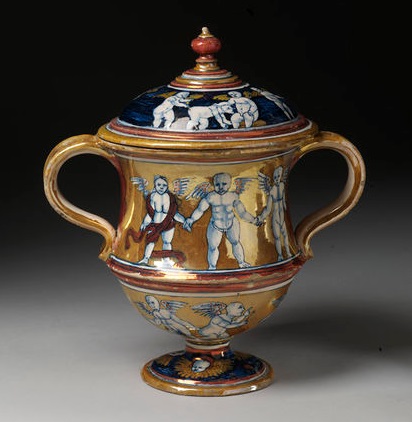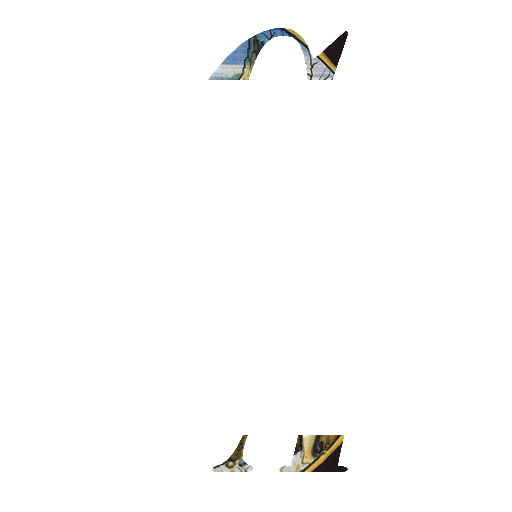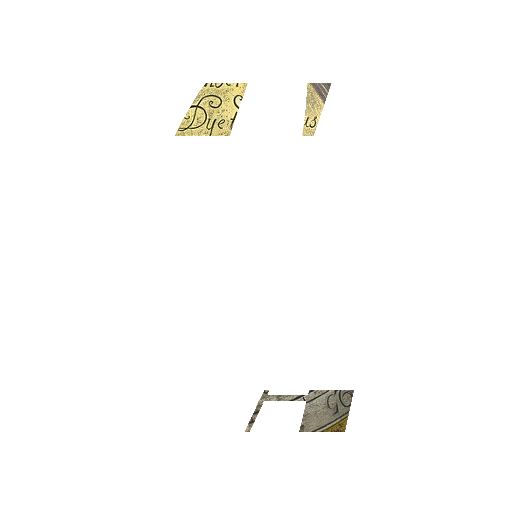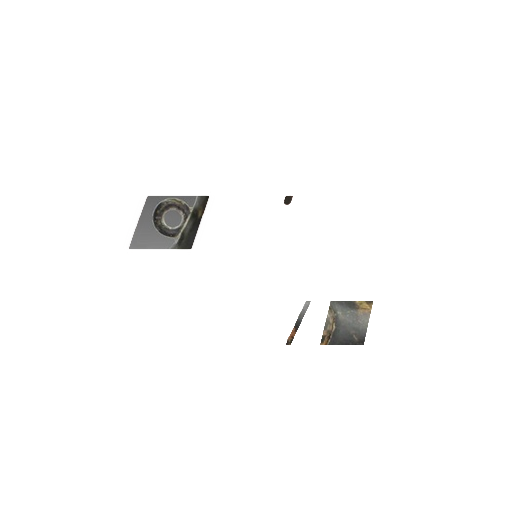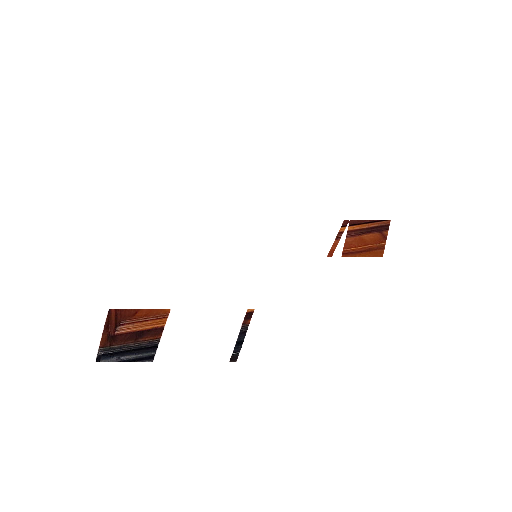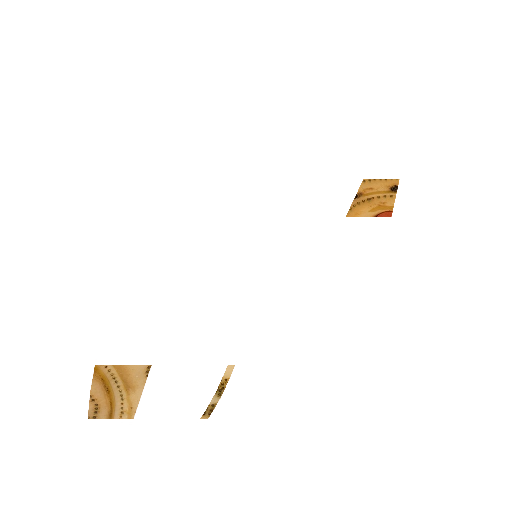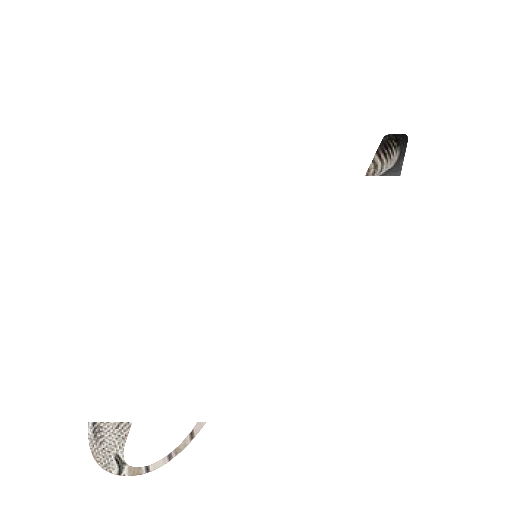The fabrique of Gubbio is one which has produced some of the most brilliant examples of ceramic art, and it is above all to Maestro Giorgio that it owes its reputation for its beautiful dishes with metallic lustres, reflets metalliques or colori cangianti. These lustres with " madreperla " are simply various pigments, in reality metals, ground to the finest powder, mixed in some vehicle, such as balsam of sulphur and oil of turpentine, and applied with a brush, in liquid form, on the surface of earthenware ; being then fired, the reduced metal, in a state of extreme tenuity, ing its characteristic sheen. The Maestro Giorgio of Gubbio, and by which gave the celebrated crimson ware and other wares decorated by them, has only just been discovered, though many artists long sought for it.
The Soulages collection contained a large number of pieces decorated by this master, and J. C. Robinson's able introduction to the catalogue contains several propositions which are worthy of consideration coming from such an expert. They deserve to be placed before every collector, and I make no apology for using them here. On the contrary, I venture to think that those who are not familiar with them will rejoice at this opportunity of studying them in their en tirety. He says : " First, that Giorgio was not the inventor of the ruby lustre, but that to all appearance exhibits without burnishspecial secret held by his immediate successors, or ruby lustre to Gubbio he succeeded to, and appar ently monopolised, the use of a pigment first employed by an earlier artist of Gubbio, to whose works Giorgio's productions have such resemblance as to render it probable that he was the master or proprietor of a botega, to which Giorgio may have succeeded. Secondly, that the signed works of Giorgio are, in reality, executed by several distinct hands.
Thirdly, that the actual handiwork of Giorgio may be distinguished with certainty, as also, perhaps equally surely, that of his son Maestro Cencio. That it is most likely that all, or at any rate a considerable proportion of the pieces painted with historical subjects (c.1530-50), obviously of the Urbino or Castel Durante fabrics, and which are heightened with lustre colours-no matter by whom the pieces may really have been executed-were, in reality, decorated with the lustre colours by M. Giorgio at a subsequent operation. Fifthly, that consequently the lustre colours were mainly confined to Gubbio, and that many of the leading majolica painters of Urbino and Castel Durante were in the habit of sending their wares to Gubbio (to M. Giorgio) to receive the lustre colours, and that probably every lustred piece of the well-known artist, Francesco Xanto of Urbino, was so enriched by M. Giorgio, either on his (Giorgio's) own account, or on commission for Xanto."
Another expert, G, Drury E. Fortnum, after citing these conclusions, has classified the lustred wares in the following manner in order to facilitate the methodical study of the rise and development of the art at Gubbio, and in the absence of positive evidence he has included the early lustred ware ascribed to Pesaro, giving a complete survey and a probable sequence of date to all the Italian lustred wares as follows;
It may be noted here that much of the Gubbio ware, including both the early and later works of Maestro Giorgio, is unmarked.
Before passing to the examination of these lustred wares in more detail a few particulars of the Maestro, Giorgio Andreoli, must be noted. He left Pavia and went first to Gubbio with his brother Salimbene, and some time later returned, but the exact facts are not recorded until 1492, when, accompanied by his younger brother Giovanni, he visited Gubbio for the second time. In 1498 they obtained the rights of citizenship, subject to a forfeit of five hundred ducats if they failed to live in the city and to practise their ceramic art. Gubbio was in the Duchy of Urbino, and shared with other pottery centres in the benefits which its dukes dispensed. Giorgio, now Maestro, was appointed castellano of Gubbio, and there he lived till about 1552. His signed works commence with 15z8 and end with 1537; one work, dated 1541, is not relied on. One of his sons, Vincenzio, also known as Maestro Cencio, assisted in his father's work and succeeded him in his f abrique, but his signature has not yet been identified. No doubt many lustre pieces were painted by this son and by other assistants. Upon a few specimens of Gubbio ware are found the following marks: " 1536 Perestinus " and " 1557 a di 28 Maggio in Gubbio per mano di Mastro Prestino," also the letters MR, combined, as well as the letter P, of various forms, These arc all ascribed to Maestro Perestino or Prestino, whose records have not yet been traced. Modern ware made at Gubbio and Doccia, at Fabriano and Pesaro, needs no comment. The delightful and brilliant colours known as " rubino," " madreperla," etc., have artistic qualities in the old majolica which reproductions cannot equal, though these last serve well enough the purposes of unprincipled dealers. So much for the epitome of history.
Returning to the classification of lustred wares, we cannot do better than follow Fortnum's guidance. The earliest lustre was applied to mezza-majolica, the coarser ware, covered with a white slip upon which were painted portraits and armorial bearings, being then glazed with the common lead glaze over which the lustre pigments were applied. At the Victoria and Albert Museum specimens of this majolica, as well as that which follows, deserve the student's careful attention in connection with the excellent handbook by Mr. Fortnum. The second class (B) shows the link between the mezza-majolica and M. Giorgio's own handwork, for the Gubbio f abrique was in full progress before 1518. Probably M. Giorgio was taught the art of making and using the ruby lustre by an artist who was employed there before he arrived. The splendid specimens at the museum form a remarkable series from which some of these illustrations are taken. The master's unsigned works are accompanied by signed pieces, all placed in class C, which show to what perfection he brought his art, which was at its best about 1525, which is the date upon several beautiful examples, marked by considerable power of drawing and great facility of invention ; foliated scrolls, eagles, masks and heads, trophies, etc., being included in his style of decoration. The " grotesques " resembled Castel Durante more than Urbino or Faenza; indeed it differed materially from these last two. The human form divine was not a strong feature of his painting, and in this comparative weakness lies another hint for identification. Then in class D are pieces painted at Gubbio, signed too with Giorgio's initials or full signature, but evidently not executed by him. No evidence is forthcoming as to his brother's work in the fabrique, nor who it was who signed with the letter N those specimens which fall into a special sub-division class (E). Some plates, dishes, etc., from other f abriques painted by other artists bear the painter's date and mark in addition to those of him who lustred it. These form an interesting class (F), but when there is no mark of Gubbio and its special ruby lustre appears upon the productions of other fabriques we must be content to believe that they were so enriched by M. Giorgio or NLN. The last division includes the M. Prestino pieces and those which bear evidence of the decadence.
When, about 1857, Mr. Fountaine gave, at Paris, four hundred guineas for a highly lustrous plate, dated 1525, decorated with a painting of " The Three Graces " after Marc Antonio, the price excited much comment. Fortnum cites a fine dish, also of Gubbio ware, which was sold for £880. In the illustrations is shown the dish of the same factory, which I saw sold at Christie's for £2,835. At the same sale a Faenza dish (Casa Pirota) realised £1,470, and a small Gubbio saucer-dish £892 10s. Maestro Giorgio's initials appeared on each of the specimens from his f abrique. His name or his initials, often with a date, occur on many specimens, some of which are given amongst the marks. Though we take into consideration the exceeding beauty of the gold, and above all, the ruby lustre, from careful inspection of many pieces, we arrive at the conclusion that the application of the lustre was a much less difficult process than the actual painting upon majolica; hence, in leaving this branch of the work to his assistants, Maestro Giorgio was wise, for his inventive talents and his perfect technique, as well as his skill as a colourist, entitle him to a high place in Italian ceramic art.
A GUBBIO MAIOLICA DISH
Umbria (Gubbio dated 1521)
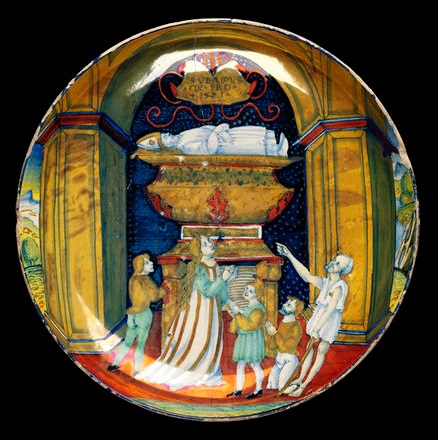
A GUBBIO MAIOLICA DISH
Umbria (Gubbio c1510-c1520)
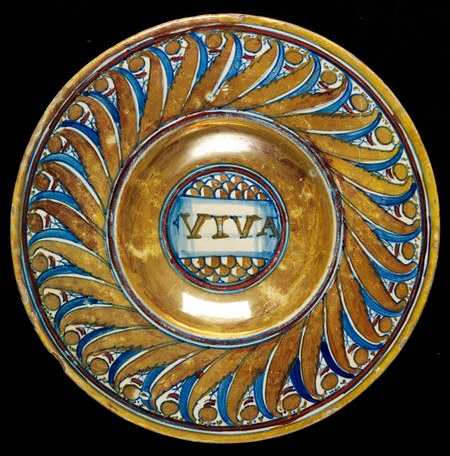
A GUBBIO MAIOLICA DRUG JAR
Umbria (Gubbio c1490-c1510)
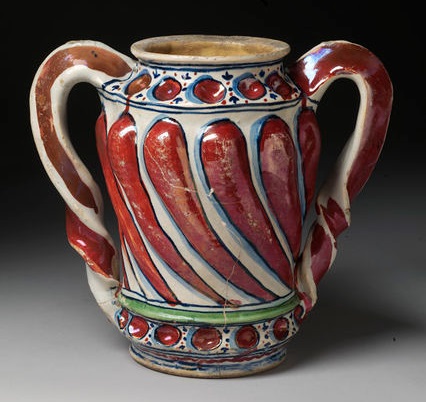
A GUBBIO MAIOLICA BOWL
Umbria (Gubbio c1515)
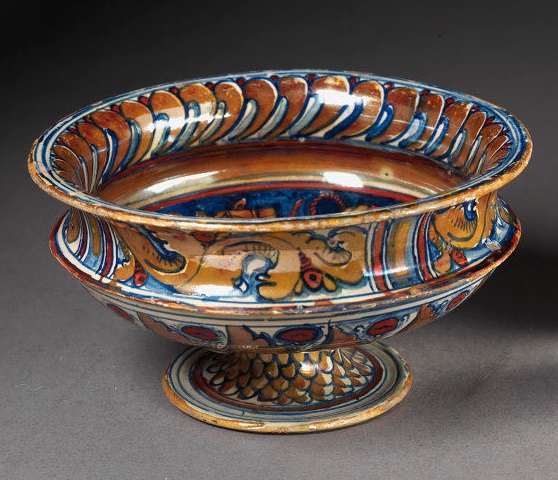
A GUBBIO MAIOLICA DISH
Umbria (Gubbio dated 1525)
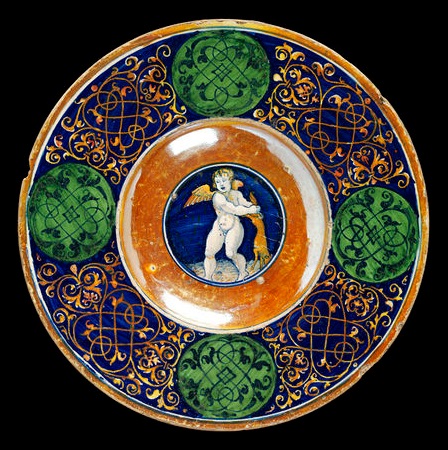
A GUBBIO MAIOLICA DISH
Umbria (Gubbio c1515)
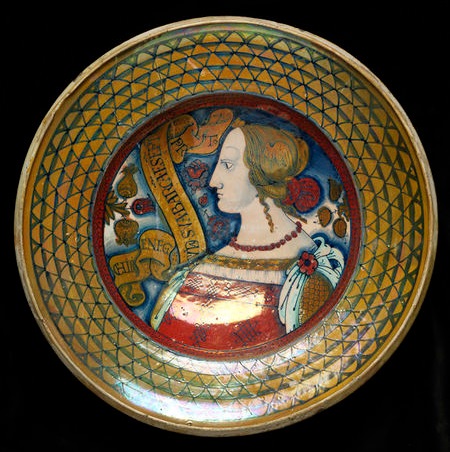
A GUBBIO MAIOLICA VASE
Umbria (Gubbio c1530)
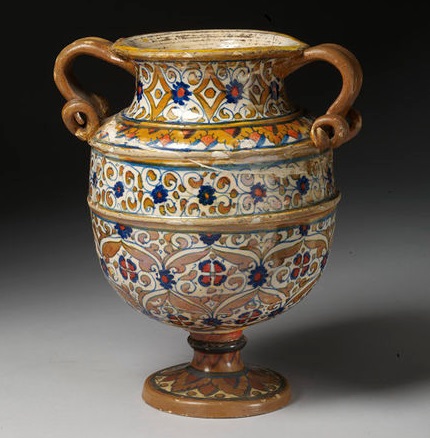
A GUBBIO MAIOLICA JUG
Umbria (Gubbio c1515-c1520)
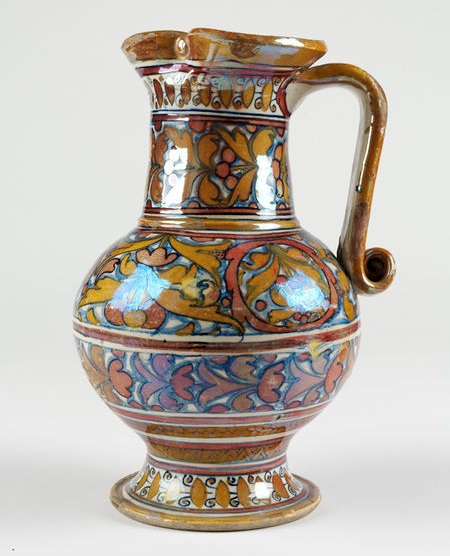
A GUBBIO MAIOLICA CANDLESTICK
Umbria (Gubbio c1525)
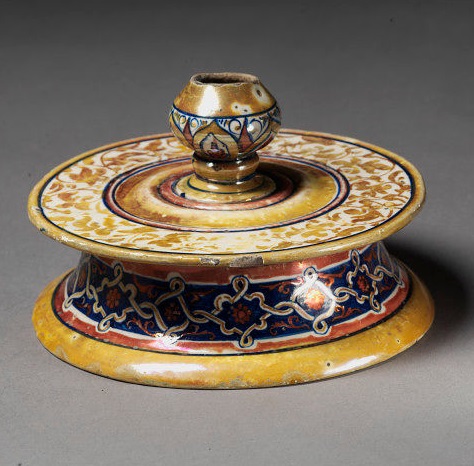
A GUBBIO MAIOLICA VASE AND COVER
Umbria (Gubbio c1515-c1520)
